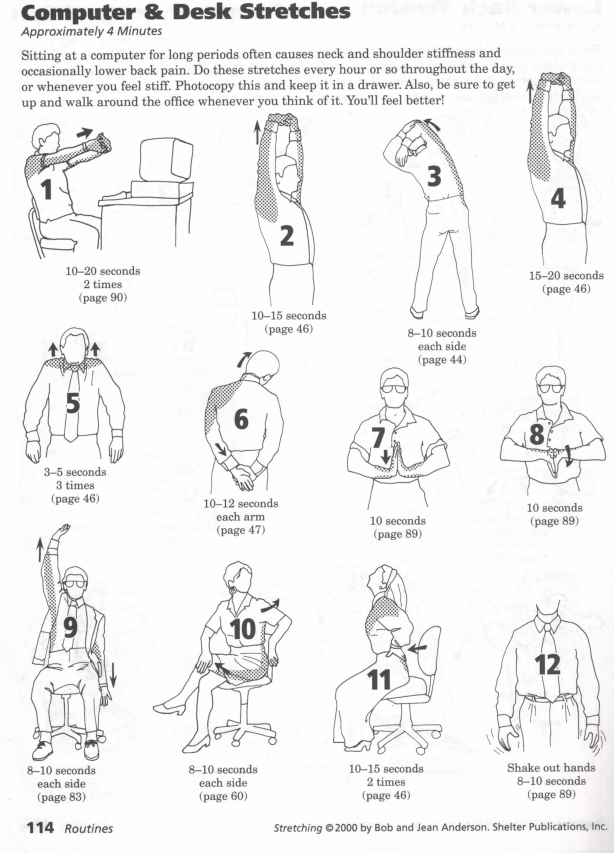Any worker may suffer from aches and pains. Work environments, repetitive motions, and postures often lead to injuries. You may be a tradie out on a construction site or a computer worker sitting at a desk. A variety of tasks performed at work can often lead to sore and stiff muscles and joints. Especially for those people who sit at a desk for prolonged periods of their day. For example
• Hunching the shoulders and
• Slouching forwards to look at a computer screen
 These two postures may lead to tightness through the upper back, shoulders, and neck. Muscular tension in the upper spine may result in tension headaches.
These two postures may lead to tightness through the upper back, shoulders, and neck. Muscular tension in the upper spine may result in tension headaches.
Most office workers are aware of the importance of having the right desk set up. The monitor, keyboard, chair, and mouse all placed in an optimal position for their body. Many offices now even have standing desks! Standing improves ergonomics and prevents prolonged periods of sitting. Even with the best desk set up, many workers will still find themselves getting sore and tight by the end of the day. The reason? They aren’t getting enough movement! Staying in the same position for prolonged periods is not good for your body. Long term inactivity can even lead to an increased risk of heart disease, diabetes, and cancer.
However, it doesn’t have to be as time-consuming as you would think to keep moving while at work. Here are some simple tips you can add to your everyday routine. These ideas can help break up the time being in the same position, whether that be sitting or standing.
1. Move around the office as much as possible:
Rather than calling or emailing a colleague, why not walk across the office and speak to them face to face. If you are often trapped at your desk, try and get up at least every 45-60 minutes for at least 5 minutes. Get a glass of water from the kitchen or simply doing a lap of the office, every bit of movement helps. Nowadays there are even Apps that you can download onto your computer or phone to remind you to get up and move. These Apps allow you to set it up according to your work schedule. Stand Up! The Work break timer is great; you can download to your iPhone from the app store.
2. Turn waiting time into exercise time:
Try and perform simple exercises such as squats or calf raises when waiting. If you’re on the phone at your desk, try simple squats by standing up and sitting down. Squat 10-15 times every time you make a call. When you're waiting at the photocopier, 10-20 calf raises can get your leg muscles moving. Do these a couple of occasions each day, and you’ve managed to work your legs and glutes without even leaving the office.
https://www.popsugar.com/fitness/Chair-Squat-Exercise-954087
https://www.spotebi.com/exercise-guide/calf-raises/
3. Change your desk:
Have a sit/stand desk? Try spending the morning standing and afternoon sitting (or vice versa). Or try and modify the position of the desk every 45-60 minutes. It is better to keep your body moving than to stay in the same position for a prolonged amount of time. Try switching the mouse to the opposite side every now and again. Use your opposite hand and arm. Challenge your mind to adapt to the change, particularly if you’re right hand dominant.
4. Take the stairs when possible:
Try and take the stairs as often as possible rather than taking the lifts. When you need to go to the toilet, rather than to go to the closest one why not go up or down a level from your office. Take the stairs and fit some exercise into your day.
5. Have a standing or walking meeting:
If you have a small group or a one on one meeting, why not try and get outside and go for a walk around the block while you talk. Not only will it get you moving but the fresh air will also be a real change from a stuffy meeting room. If you have a larger group meeting and a walk isn’t possible, try and get everyone standing for a part or all of the meeting.
6. Get up and move in your breaks:
Try and get up and move as much as possible in any breaks you have. It can be as short as going to the kitchen and eating with other colleagues. Try to get outside and go for a short walk around the block after you’ve eaten. The change of scenery will also help refresh your mind and clear your head from sitting in the same space all day.
7. Try walking or riding to work once per week:
If you don’t live too far from work, lace up your runners to ride/walk to work, as often as you can each week. Why not try walking/riding to the train station or bus stop rather than driving there. If you can't ditch the car altogether, try to park a few blocks away and walk to work.
8. Stretch at your desk:
Stretching is another important step that can be easily added to your day. Simple stretches at your desk may help to prevent muscle tightness and soreness. The picture below will show you several stretches you can perform whilst at work and can you can save the image for easier access whilst at work.

Adding in a few, or all of these tips to your work day can help to keep you moving and in turn prevent many aches and pains. However, if you have any questions or existing aches/pains from work feel free to make an appointment to discuss how osteopathy may be able to help you.
Written By Emma Cronin

